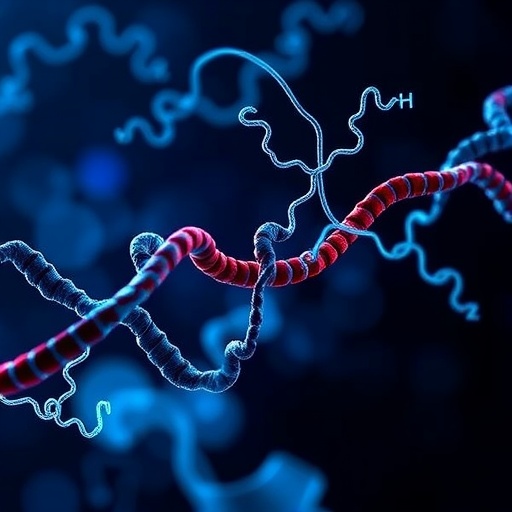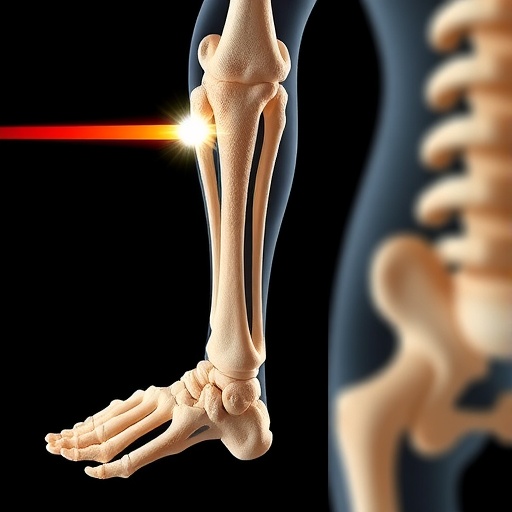
A new frontier in understanding the molecular intricacies of cellular nutrient sensing has emerged with groundbreaking insights into the dynamic regulation of mTORC1 by amino acids. Central to this regulatory network is the complex interplay between GATOR2, a multi-subunit scaffold essential for transmitting amino acid signals, and CASTOR1, a cytosolic arginine sensor. Recent advances utilizing high-resolution cryo-electron microscopy (cryo-EM) have elucidated the atomic details of the GATOR2–CASTOR1 complex, providing a vivid blueprint of how arginine availability orchestrates structural rearrangements that modulate mTORC1 signaling.
The mTORC1 pathway serves as a pivotal controller of cell growth and metabolism, integrating nutrient cues to finely tune anabolic and catabolic processes. CASTOR1 operates as an arginine sensor, forming a homodimer that binds directly to the GATOR2 scaffold. The cryo-EM structure, resolved at an impressive 3.4-ångström resolution, reveals that each CASTOR1 protomer engages a distinct MIOS β-propeller within the GATOR2 complex, specifically at the ‘brace’ region formed by dimerization of two MIOS subunits. This structural configuration confirms the necessity of both CASTOR1 protomers for high-affinity GATOR2 binding and effective inhibition of mTORC1 signaling under arginine-deprived conditions.
Intriguingly, CASTOR1 also transiently associates with the ‘glove’ side of GATOR2 through a single MIOS β-propeller interaction in a subset of particles analyzed, though these interactions are likely non-physiological artifacts due to experimental conditions involving excess CASTOR1. The principal inhibitory interaction, therefore, involves a symmetric engagement of the CASTOR1 homodimer with the brace interface, underscoring the geometric precision of the regulatory apparatus.
.adsslot_W1c43BLXxE{width:728px !important;height:90px !important;}
@media(max-width:1199px){ .adsslot_W1c43BLXxE{width:468px !important;height:60px !important;}
}
@media(max-width:767px){ .adsslot_W1c43BLXxE{width:320px !important;height:50px !important;}
}
ADVERTISEMENT
At the molecular interface, three signature loops in the MIOS β-propeller—defined as β2.4–β3.1, β3.2–β3.3, and β3.4–β4.1—compose the CASTOR1-binding surface. Among them, the β3.2–β3.3 loop emerges as a key player via its Arg137 residue, which inserts into a specialized cleft between the ACT2 and ACT4 domains of CASTOR1, forming a crucial salt bridge with Asp121. This interaction not only anchors CASTOR1 but also serves as a linchpin substantiated by mutational analyses demonstrating that alteration of Arg137 disrupts GATOR2 binding.
Adjacent MIOS residues, including Lys111, His112, and Ala113 within the β2.4–β3.1 loop, contribute additional hydrogen bonds to stabilize the complex, engaging residues Ser258 and Tyr118 of CASTOR1—highlighted in prior studies as essential for GATOR2 association. Complementary contacts arise from a flexible 8-residue loop in CASTOR1, β6–α3 (residues 83–90), which interfaces at the junction of the third and fourth MIOS blades but appears less critical due to weaker electrostatic interactions and lower resolution in structural data.
Cell-based complementation experiments further validate the structural findings. MIOS knockout cells expressing the Arg137Ala mutant exhibit impaired GATOR2–CASTOR1 interaction and compromised arginine-dependent mTORC1 regulation, pinpointing Arg137 as a molecular switch for sensor engagement. Similarly, mutations in CASTOR1 residues Tyr118, Gln119, or Asp121 abolish GATOR2 binding and prevent suppression of mTORC1 signaling, solidifying the biochemical and cellular relevance of the interface elucidated by cryo-EM.
Interestingly, the interaction site for arginine binding within CASTOR1 is spatially distinct from the GATOR2 docking interface, suggesting an allosteric regulatory mechanism. Comparative structural analysis between the GATOR2-bound, arginine-free CASTOR1 and the arginine-bound apo form has uncovered subtle yet significant conformational rearrangements. Notably, the CASTOR1 homodimer exhibits an approximate 15-degree rotation between protomers upon GATOR2 engagement, a configuration consistent across brace and glove binding, pointing toward a plasticity in sensor architecture.
A previously unresolved region in CASTOR1—the β6–α3 loop—assumes a novel and unique conformation in the GATOR2-bound state, diverging from crystal structures of apo or arginine-bound CASTOR1. This disordered and flexible loop is posited to undergo significant repositioning upon arginine binding, thereby influencing sensor–scaffold affinity. Detailed structural inspection reveals that arginine binding collapses the ligand-binding pocket lid (loop β14–α7), creating hydrophobic steric clashes that shift helix α7 towards MIOS by approximately half a helical turn.
This displacement propagates to helix α3, inducing a sharp kink of about 60 degrees stabilized by interactions involving Tyr297, Val94, and Thr95. The critical movement of helix α3 drags the β6–α3 loop into a position where Ala92 collides sterically with MIOS Arg137, effectively disrupting the key anchoring salt bridge and prompting dissociation of CASTOR1 from GATOR2. Mutagenesis studies corroborate this model: deletion of residues 85–90 in the β6–α3 loop enhances GATOR2 binding even in arginine-replete conditions, while a Val94Asp substitution alters helix α3 dynamics and diminishes arginine-induced release, underscoring the functional importance of these structural rearrangements.
Molecular dynamics simulations complement the static cryo-EM snapshot by revealing that the ligand-binding lid maintains a closed conformation over microsecond timescales, hinting at an ordered, multistep arginine-binding mechanism. During ligand unbinding, arginine transiently interacts near helix α7 for durations averaging 20 nanoseconds before full dissociation, suggesting an intermediate state critical for conformational signaling. Mutation of Glu277 in helix α7 attenuates arginine-induced dissociation without perturbing orthosteric binding, reinforcing the notion of helix α7 as an essential conduit for allosteric communication within CASTOR1.
The structural analysis extends beyond the sensor protein to encompass GATOR2 itself. Binding of CASTOR1 induces a physical separation of the MIOS brace β-propellers, which in turn rearranges SEH1L(MIOS) subunits. This rearrangement destabilizes the zinc-finger domain of the WDR59 subunit, whose density diminishes in the GATOR2–CASTOR1 complex relative to apo GATOR2. Loss of the WDR59 ZnF domain reduces scaffold rigidity and creates a hinge that enables overall compaction and shape remodeling of GATOR2 into a more squared architecture.
Functional consequences of WDR59 perturbation were demonstrated by engineering a Cys914Ala/Cys917Ala mutation that mimics the CASTOR1-induced effect. This mutant exhibits weakened interactions with the GATOR1–KICSTOR subcomplex and blunted activation of mTORC1 signaling, linking scaffold conformational dynamics to downstream regulatory outcomes. Notably, CASTOR1 preferentially co-immunoprecipitates with GATOR2, in contrast to other amino acid sensors such as Sestrin2 and SAMTOR, which exhibit broader complex associations, highlighting the specificity of CASTOR1-mediated allosteric regulation within the mTORC1 network.
Collectively, these results illuminate a sophisticated mechanism whereby arginine sensing is communicated to the mTORC1 pathway through precise structural and conformational tuning of the GATOR2–CASTOR1 complex. This interplay highlights the nuanced allosteric controls governing nutrient signaling, illustrating how spatially discrete binding events translate into large-scale scaffold remodeling and signal propagation. The combination of cutting-edge cryo-EM, mutational analysis, molecular dynamics, and cellular validation paints a comprehensive picture of amino acid sensing at the molecular level, providing foundational knowledge with potential therapeutic implications in metabolic disorders and cancer.
This study marks a pivotal advance in decoding the language of nutrient sensing, demonstrating how individual amino acid availability can orchestrate complex molecular machines to regulate cellular growth. By unmasking the dynamic structural rearrangements at the heart of the GATOR2–CASTOR1 interaction, the research sets the stage for future efforts aiming to modulate mTORC1 activity in disease contexts where nutrient signaling is disrupted. The clear mechanistic insights gleaned from this high-resolution structural work underscore the power of integrative approaches to unravel the intricacies of cellular signaling pathways.
Subject of Research: Regulation of mTORC1 signaling by amino acid availability through the structural dynamics of the GATOR2–CASTOR1 complex.
Article Title: Structural basis for the dynamic regulation of mTORC1 by amino acids.
Article References:
Valenstein, M.L., Wranik, M., Lalgudi, P.V. et al. Structural basis for the dynamic regulation of mTORC1 by amino acids. Nature (2025). https://doi.org/10.1038/s41586-025-09428-7
Image Credits: AI Generated
Tags: arginine availability effectsarginine sensor mechanismscell growth metabolism regulationcellular nutrient sensingcryo-electron microscopy insightsGATOR2 CASTOR1 complexGATOR2 scaffold dynamicshigh-resolution cryo-EM findingsmolecular interactions in nutrient sensingmTORC1 amino acid regulationmTORC1 signaling modulationstructural biology of mTORC1





